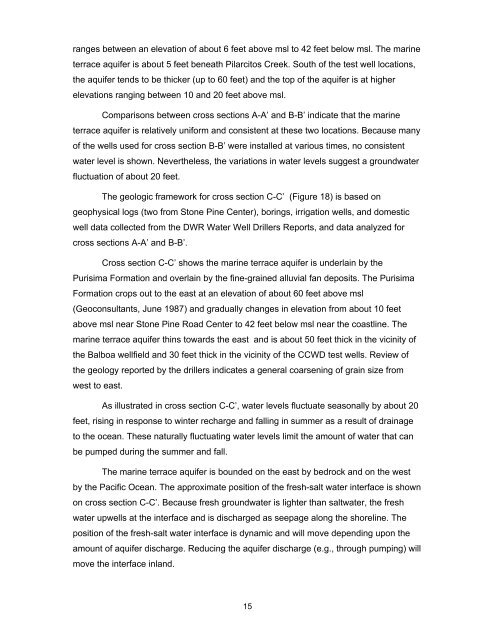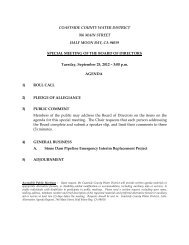Lower Pilarcitos Creek Groundwater Basin Study - Coastside ...
Lower Pilarcitos Creek Groundwater Basin Study - Coastside ...
Lower Pilarcitos Creek Groundwater Basin Study - Coastside ...
You also want an ePaper? Increase the reach of your titles
YUMPU automatically turns print PDFs into web optimized ePapers that Google loves.
anges between an elevation of about 6 feet above msl to 42 feet below msl. The marine<br />
terrace aquifer is about 5 feet beneath <strong>Pilarcitos</strong> <strong>Creek</strong>. South of the test well locations,<br />
the aquifer tends to be thicker (up to 60 feet) and the top of the aquifer is at higher<br />
elevations ranging between 10 and 20 feet above msl.<br />
Comparisons between cross sections A-A’ and B-B’ indicate that the marine<br />
terrace aquifer is relatively uniform and consistent at these two locations. Because many<br />
of the wells used for cross section B-B’ were installed at various times, no consistent<br />
water level is shown. Nevertheless, the variations in water levels suggest a groundwater<br />
fluctuation of about 20 feet.<br />
The geologic framework for cross section C-C’ (Figure 18) is based on<br />
geophysical logs (two from Stone Pine Center), borings, irrigation wells, and domestic<br />
well data collected from the DWR Water Well Drillers Reports, and data analyzed for<br />
cross sections A-A’ and B-B’.<br />
Cross section C-C’ shows the marine terrace aquifer is underlain by the<br />
Purisima Formation and overlain by the fine-grained alluvial fan deposits. The Purisima<br />
Formation crops out to the east at an elevation of about 60 feet above msl<br />
(Geoconsultants, June 1987) and gradually changes in elevation from about 10 feet<br />
above msl near Stone Pine Road Center to 42 feet below msl near the coastline. The<br />
marine terrace aquifer thins towards the east and is about 50 feet thick in the vicinity of<br />
the Balboa wellfield and 30 feet thick in the vicinity of the CCWD test wells. Review of<br />
the geology reported by the drillers indicates a general coarsening of grain size from<br />
west to east.<br />
As illustrated in cross section C-C’, water levels fluctuate seasonally by about 20<br />
feet, rising in response to winter recharge and falling in summer as a result of drainage<br />
to the ocean. These naturally fluctuating water levels limit the amount of water that can<br />
be pumped during the summer and fall.<br />
The marine terrace aquifer is bounded on the east by bedrock and on the west<br />
by the Pacific Ocean. The approximate position of the fresh-salt water interface is shown<br />
on cross section C-C’. Because fresh groundwater is lighter than saltwater, the fresh<br />
water upwells at the interface and is discharged as seepage along the shoreline. The<br />
position of the fresh-salt water interface is dynamic and will move depending upon the<br />
amount of aquifer discharge. Reducing the aquifer discharge (e.g., through pumping) will<br />
move the interface inland.<br />
15



